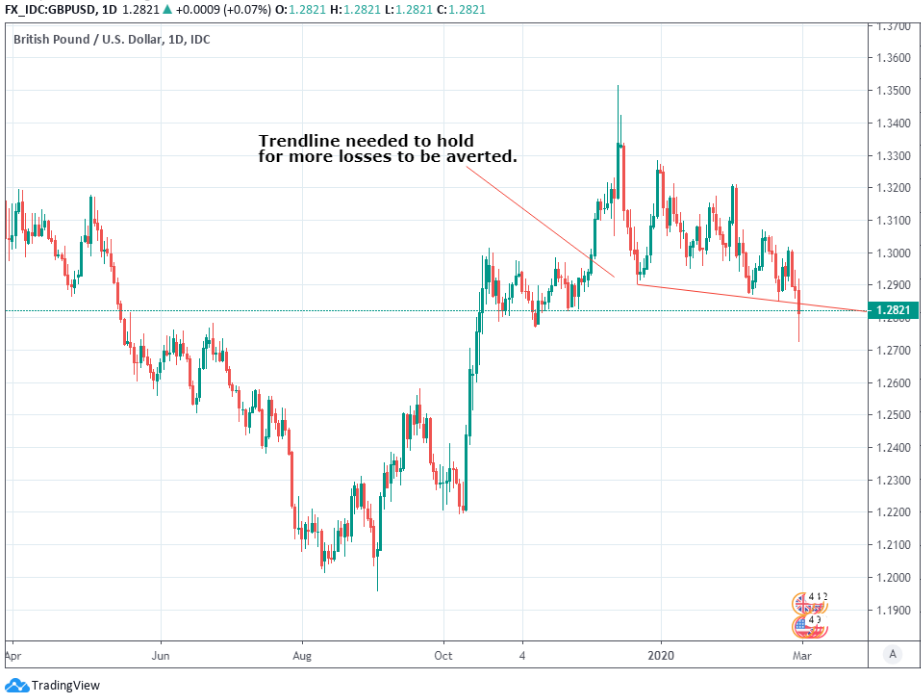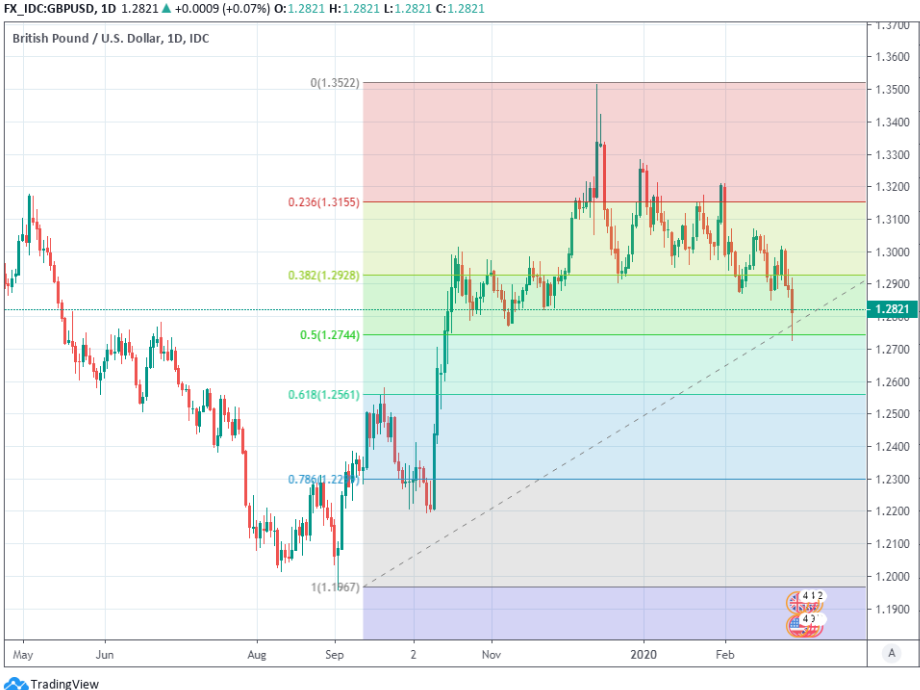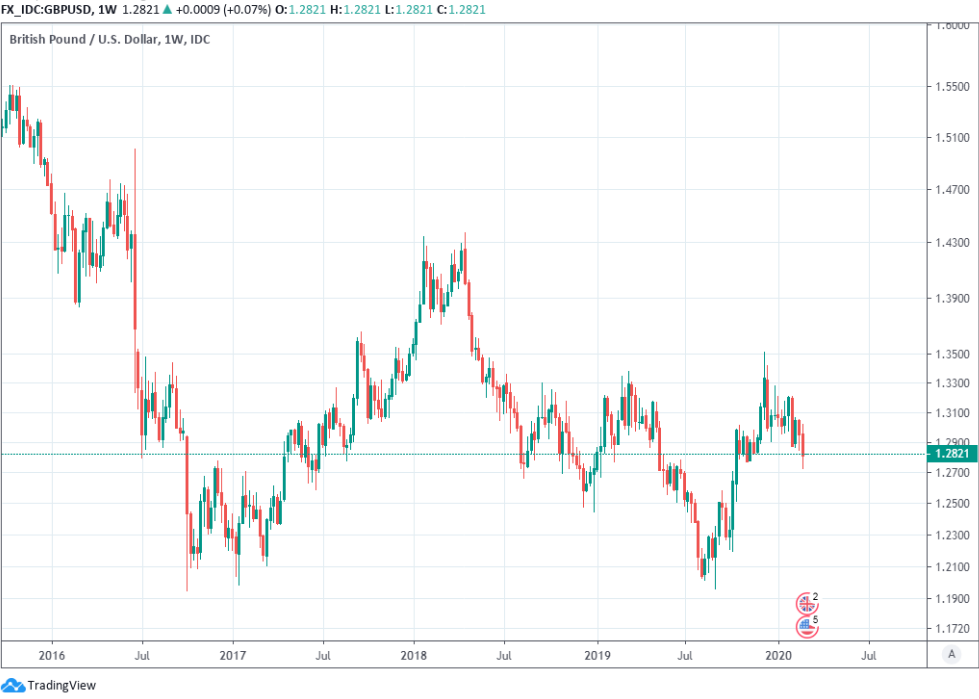Pound-to-Dollar Week Ahead: Downside Risks Abound after Trend Snaps
- Written by: James Skinner
-
- GBP/USD snaps multi-month uptrend on charts ahead of weekend.
- GBP/USD support at 1.2744 but 1.26 level and below are clear risks.
- Signs of 'community outbreak' of coronavirus near capital London.
- Surrey, Berkeshire both have cases of unexplained transmission.
- As virus outbreak grows in U.S., Italy, and other parts of Europe.
- Size of UK financial sector, threat to London, sees GBP vulnerable.
- EUR benefits from liquidation of 'carry' trades in emerging markets.

Image © Adobe Images
- GBP/USD Spot rate: 1.2809, -1.06% in last week
- Indicative bank rates for transfers: 1.2471-1.2507
- Transfer specialist indicative rates: 1.2628-1.2705 >> Get your quote now
The Pound-to-Dollar rate came under mounting pressure heading into the weekend and has now broken a multi-month uptrend on the charts, creating a bearish technical picture on the charts just as the evolving coronavirus not-pandemic threatens to weigh disproportionately on Sterling.
Sterling has suffered heavy losses amid turmoil for risk assets like stocks and commodities as well as the currencies that underwrite them. In ordinary times such brutal punishment might be enough to mean that at least a short period of stabilisation was owed if-not due but this week, respite could be unlikely.
Some central bankers are of the view that recent price action in some markets represents an overreaction to the coronavirus on the part of investors but they know better than anybody that prices will reflect an average of possible outcomes for any given situation at any given time.
The uncomfortable reality for policymakers is that in the rapidly evolving coronavirus situation the worst case scenario outcome is potentially significant enough to mean the appropriate average for prices is skewed a long way below where valuations were, and possible even where they currently are sitting.
And last week's losses were already severe enough to have seen the Pound-to-Dollar rate break its multi-month uptrend.
“Only a close below 1.2849/41, the recent low and support line would put the 55 week ma at 1.2799 and the 200 day moving average at 1.2697 back on the plate,” says Karen Jones, head of technical analysis for currencies, commodities and bonds at Commerzbank in an early morning research note.
Above: Pound-to-Dollar rate at daily intervals with pierced trendline support marked out.
Sterling fell through a crucial technical support level at 1.2841 to trade comfortably beneath the 1.28 handle heading into the London close, although subsequent price action and a fibonacci retracement of multi-month trend indicates the exchange rate might find support around 1.2744.
Beyond that level, however, the Pound will not have much support before 1.26 and could easily find itself knocking on the door of a return to 1.23 if selling is sustained over the coming weeks. And selling may be sustained now the UK has seen its first sign of a 'community outbreak' of coronavirus.
A first case of coronavirus was identified in England on Saturday in which the disease was thought to have been “passed on in the UK,” Chief Medical Officer Chris Whitty said. Possibly the first sign of a 'community outbreak.’
A man and subsequently others were found with the viral pneumonia in an undisclosed part of the county of Surrey, which sits on the border of London. A primary school teacher in Reading, Berkeshire - another county bordering London - was confirmed to be suffering from virus. And there has since been an incidence of possible ‘community infection’ in Essex, another county bordering the capital London. The UK had 35 confirmed cases as of Sunday afternoon.
“The clear and obvious risk, which the financial markets are already contemplating, is that things get worse before they get better. That could include a further weakening in the global economy as the number of cases of coronavirus in Europe and the US rise and/or their governments shut down parts of their economies to control the spread of the virus,” says Paul Dales, chief UK economist at Capital Economics in a note to clients Friday.
Above: Pound-to-Dollar rate at daily intervals with 50% Fibonnacci retracement line offering support at 1.2744.
The U.S. government also confirmed its first death case at the weekend and the White House has told Americans to expect more over the coming weeks. The Italian government had declared 1128 cases of coronavirus as of Saturday, with close to a thousand in the Lombardy, Veneto and Emilia-Romagna regions.
Eleven towns are under “lockdown” with nobody able to enter or leave affected areas and that government has now legislated to suspend payment deadlines for all debts to local authorities in the affected areas and provided for a EUR500 stipend to workers in those areas for at least the next three months.
The idea that such disruptive restrictions may soon be seen in the world’s most developed economies, and hubs of global finance, is no longer far-fetched.
"Coronavirus may very well be a challenge in the weeks and months ahead. But I have no doubt that with the help of the NHS and its incomparable staff this country will get through it – and beat it," says Prime Minister Boris Johnson, will chair a meeting of COBRA on Monday as the government prepares to publish an updated action plan on the response expected of the health care system and the public to COVID-19. Further details are below.
Above: Pound-to-Dollar rate at weekly intervals.
AA
Pound Sterling: What to Watch
Pound Sterling received a drubbing heading into the weekend after the government put the idea of an ‘Australia deal’ Brexit on the table ahead of trade talks with the EU this week and as stock markets crumbled across the globe in response to the increasingly rapid spread of coronavirus outside of China, both being things that may continue to pressure the Pound in the week ahead.
The British government is expected to encourage companies to allow more staff to work from home in its updated action plan this week. It's also likely to discourage unnecessary travel as part of a ‘social distancing’ strategy that would delay the peak of the outbreak until later in the year.
It's also expected to allow the "emergency registration" of staff who've left the health service to combat staff shortages in the event of a large outbreak. The document will be published this week and will also outline steps the government will take to manage COVID-19 if there is a sustained UK epidemic.
This and the weekend’s events mean households, companies and investors could now potentially be facing a momentous disruption to the ordinary course of business and it's not possible for anybody to reliably say how long such disruption might last for or what other effects it could have. For Pound Sterling, which underwrites a financial sector where assets under management are more than three times the UK’s annual GDP, this could be very bad news.
"The pound is a structurally weak currency and it remains sensitive to global investors' appetite for risk. Large capital inflows are required to keep sterling stable, given that the U.K. runs a persistent current account deficit, equal to nearly 4% of GDP. Sterling depreciated by 25% during the 2007/08 crisis primarily due to a global pullback in cross-border finance, not a material shift in interest rate differentials," says Samuel Tombs, chief UK economist at Pantheon Macroeconomics. "If virus-related anxiety causes investors globally to pause on all risky acquisitions, or, in the worst case, de-risk their existing portfolios, sterling likely will struggle again."
Sterling is underpinned by continuous flows of external finance into and out of both the exchequer as well as City of London, although if a coronavirus outbreak were to be found on the borders of the capital then the City’s ability to continue functioning may be questioned. There are many different scenarios in which those financial inflows might dry up or be dwarfed by outflows from capital, and all of those scenarios would be bad news for the Pound.
Already the turmoil in financial markets was significant enough to have prompted some economists to contemplate the prospects of the Bank of England (BoE) feeling compelled to issue a statement over the coming days, and to potentially even cut interest rates in the weeks ahead. Pound Sterling is not prepared for an interest rate cut because on Friday the overnight-index-swap implied Bank Rate for March 26 was just 0.61%, above the 0.50% that would prevail following an actual cut.
Federal Reserve Chairman Jerome Powell already issued a statement on Friday evening.
“Even if the financial markets just continue to fear such developments and equity prices continue to fall by 3% a day, then the MPC may act. If so, then its next scheduled meeting on 26th March feels a long way away. It could release a statement before then, perhaps coordinated with other central banks, saying it is ready to provide support and liquidity if needed. And if that doesn’t do the job, we wouldn’t rule out the MPC cutting rates at an emergency meeting,” says Capital Economics’ Dales.
There are no major economic figures expected from the UK in the week ahead although the Brexit negotiations will begin in the shadow of the coronavirus story and with each side having conflicting demands and a confrontational stance.
This matters more for the Pound in the medium-term after the government said last week the UK could walk away from the trade talks with the EU if the broad outline of a deal has not been reached before June.
“The UK and the EU will sit at the negotiating table on Monday and we suspect the highly confrontational tone after the recent remarks by UK officials will keep prevailing in the headlines. This should translate into additional uncertainty regarding the future of UK trade relationships with the bloc and selling pressure on sterling should remain sustained,” says Chris Turner, head of FX strategy at ING. “In light of this we may see EUR/GBP consolidate above 0.85 and GBP/USD edging below 1.28 next week.”
AA
The Dollar: What to Watch
The Dollar was sold heavily at times last week amid multiple headwinds for the U.S. currency, which might prevail over smaller, riskier rivals like Pound Sterling in the week ahead but could remain on the back foot against safe-havens like the Swiss Franc and Japanese Yen.
The U.S. is also contending with its own first signs of coronavirus ‘community outbreak’ as well as meltdown in stock markets, both of which have helped send investors stampeding into the bond market, driving sovereign yields down to new record lows while derivatives market traders are increasingly pricing-in three interest rate cuts from the Federal Reserve (Fed) in the months ahead.
“The fundamentals of the U.S. economy remain strong. However, the coronavirus poses evolving risks to economic activity. The Federal Reserve is closely monitoring developments and their implications for the economic outlook. We will use our tools and act as appropriate to support the economy,” says Federal Reserve Chairman Jerome Powell, in a late Friday statement.
Three Fed rate cuts would obliterate much of the Dollar’s yield advantage against some major rivals if not offset by countervailing rate cuts from elsewhere, while the entire time that equity benchmarks are marching toward the bear market territory denoted by a 20% loss, the greenback could continue to be bloodied by outflows against a range of currencies. And for the Dollar Index, these losses are being exacerbated by outperformance from the Euro.
“After such a pronounced correction lower in equity markets, it is very unlikely that this bout of risk aversion will reverse quickly,” says Lee Hardman, a currency analyst at MUFG. “Long-held positions are therefore in our view under greater risk of liquidation. The return of capital will be more important than the return on capital and hence position liquidation could have much more to run. The euro could be the surprise beneficiary here. Substantial outflows included in the ‘other investment’ outflow in BoP data indicates large use of the euro as a funding currency. Expect JPY, CHF and EUR to continue to benefit in these financial market conditions."
Europe’s single currency saw its biggest gains over the Dollar last week since August 2019 when China sent its Yuan falling to a decade-low, prompting steep losses for other emerging market currencies in the process.
This was as investors sold out of riskier bets that had been funded by Euro denominated borrowings in less turbulent times.
The Euro is outperforming for now but some expect it will eventually come back down to earth because its economy will also be hit hard by the evolving not-pandemic, which has already had a significant impact in Italy. And if the Euro does reverse course and head lower at any point then its 57% weighting in the Dollar Index could turn the tide for the greenback, which is still likely to get the better of smaller rivals like Sterling and the commodity Dollars.
“The more severe the rally in the pair becomes, the more we are convinced that it is detached from underlying fundamentals. But this also means that we are less inclined to want to fight it,” says Stephen Gallo, European head of FX strategy at BMO Capital Markets.
In the meantime, Institute of Supply Management (ISM) PMI surveys of the manufacturing and services sectors are due for the month of February this week and so too is the latest non-farm payrolls report although both events could easily be drowned out by the evolution of the coronavirus headwind.
Consensus is looking for remarkable stability in the PMI surveys that won’t be difficult to disappoint. Markets are looking for the U.S. economy to have created 185k new jobs in February and for the unemployment rate to have fallen back to its earlier 3.5% level, with average hourly wages seen growing at 0.3% on a month-on-month basis.
“The situation is increasingly developing into a massive demand-shock rather than a supply-shock, why havens could be bought still. We fear that the Chinese PMI is a hint of what could be coming up in US and European key figures in a month or two,” warns Martin Enlund, chief FX strategist at Nordea Markets.












